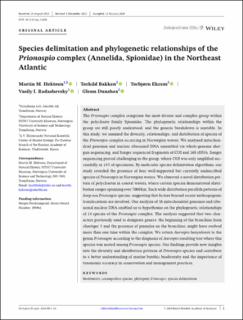| dc.contributor.author | Hektoen, Martin Mejdell | |
| dc.contributor.author | Bakken, Torkild | |
| dc.contributor.author | Ekrem, Torbjørn | |
| dc.contributor.author | Radashevsky, Vasily I. | |
| dc.contributor.author | Dunshea, Glenn John | |
| dc.date.accessioned | 2024-02-26T12:36:24Z | |
| dc.date.available | 2024-02-26T12:36:24Z | |
| dc.date.created | 2024-02-19T12:48:34Z | |
| dc.date.issued | 2024 | |
| dc.identifier.citation | Zoologica Scripta. 2024, . | en_US |
| dc.identifier.issn | 0300-3256 | |
| dc.identifier.uri | https://hdl.handle.net/11250/3119919 | |
| dc.description.abstract | The Prionospio complex comprises the most diverse and complex group within the polychaete family Spionidae. The phylogenetic relationships within the group are still poorly understood, and the generic breakdown is unstable. In this study, we assessed the diversity, relationships, and distribution of species of the Prionospio complex occurring in Norwegian waters. We analysed mitochondrial genomes and nuclear ribosomal DNA assembled via whole-genome shotgun sequencing, and Sanger sequenced fragments of COI and 16S rDNA. Sanger sequencing proved challenging in the group, where COI was only amplified successfully in 14% of specimens. By molecular species delimitation algorithms, our study revealed the presence of four well-supported but currently undescribed species of Prionospio in Norwegian waters. We observed a novel distribution pattern of polychaetes in coastal waters, where certain species demonstrated distribution ranges spanning over 7000 km. Such wide distribution parallels patterns of deep-sea Prionospio species, suggesting that factors beyond recent anthropogenic translocations are involved. Our analysis of 38 mitochondrial genomes and ribosomal nuclear DNA enabled us to hypothesise on the phylogenetic relationships of 14 species of the Prionospio complex. The analysis suggested that two characters previously used to designate genera: the beginning of the branchiae from chaetiger 3 and the presence of pinnules on the branchiae, might have evolved more than one time within the complex. We return Aurospio banyulensis to the genus Prionospio according to the diagnosis of Aurospio resulting tree where this species was nested among Prionospio species. Our findings provide new insights into the diversity and distribution patterns of Prionospio species and contribute to a better understanding of marine benthic biodiversity and the importance of taxonomic accuracy in conservation and management practices. | en_US |
| dc.language.iso | eng | en_US |
| dc.publisher | Wiley | en_US |
| dc.rights | Navngivelse 4.0 Internasjonal | * |
| dc.rights.uri | http://creativecommons.org/licenses/by/4.0/deed.no | * |
| dc.title | Species delimitation and phylogenetic relationships of the Prionospio complex (Annelida, Spionidae) in the Northeast Atlantic | en_US |
| dc.title.alternative | Species delimitation and phylogenetic relationships of the Prionospio complex (Annelida, Spionidae) in the Northeast Atlantic | en_US |
| dc.type | Peer reviewed | en_US |
| dc.type | Journal article | en_US |
| dc.description.version | publishedVersion | en_US |
| dc.source.pagenumber | 0 | en_US |
| dc.source.journal | Zoologica Scripta | en_US |
| dc.identifier.doi | 10.1111/zsc.12648 | |
| dc.identifier.cristin | 2247509 | |
| cristin.ispublished | true | |
| cristin.fulltext | original | |
| cristin.qualitycode | 1 | |

